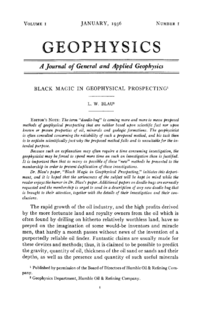Pseudogeophysics
/ Seventy-five years ago, the first paper of the first issue of the journal Geophysics was published: Black magic in geophysical prospecting by Ludwig Blau of the Humble Oil and Refining Company. If you are an exploration geoscientist, you must read it. Then go and get someone else to read it too.
Seventy-five years ago, the first paper of the first issue of the journal Geophysics was published: Black magic in geophysical prospecting by Ludwig Blau of the Humble Oil and Refining Company. If you are an exploration geoscientist, you must read it. Then go and get someone else to read it too.
The paper is remarkable for a few reasons, apart from simply being first:
- it is scientific, but warm and humorous, and utterly compelling
- it is subtle but devastating in its condemnation of some of the day's technology
- the critical approach Blau obtusely describes is still relevant to us today
How to crack a nut
There are two parts to the paper: a brief spotter's guide to black magic, followed by eighteen examples from the author's own experience.
Blau's guide to the characterisitcs of a nutty inventor is timeless. It presages John Baez's wonderful Crackpot Index. Here are the highlights:
- The inventor has been working alone for many years, usually about 20
- The inventor has no formal training, regarding this as a hindrance
- The inventor has many Nobel prize-winning scientist friends
- None of these friends understand the contraption in question (owing to their hindrances)
Thus it was proved...
Yet more enlightening is Blau's categorization of geophysical technology. He identifies five modes of detection, from the merely implausible to the downright bizarre:
- Particle radiation, akin to α or β radiation
- Non-gravitaitonal forcefields, attracting 'bait' oil
- Radiant vibrations, detectable by skilled divination
- Electromagnetic waves, readily received by a radio
- Sexual emanations. No, really.
But it's the vivid descriptions of the contraptions and their inventors that light the paper up. Blau's brief but scathing reviews are so drily delivered, one imagines he must have been a man of few, but golden, words.
Here is Blau is describing the conclusion, and coup de grâce, of a hotel meeting with a pair of gentlemen peddling a stick which, when primed with a capsule of oil (or any other sought-after substance), points decisively to the nearest reservoir:
When the “bait” was changed to whiskey, the device in the hands of the inventor stubbornly pointed to a leather bag lying on the bed; the inventor asked his friend how this could possibly be explained since they had finished the last bottle that morning and he had not bought more. Upon opening the bag a pint bottle was revealed and the friend admitted having bought it that afternoon without telling the inventor about it. Thus it was proved that the device was not manipulated or influenced by the operator.
I would give my eye teeth to have been a fly on the wall during that scene.

References
Blau, L (1936). Black magic in geophysical prospecting. Geophysics 1 (1). DOI:10.1190/1.1437076
I am very grateful to the Society of Exploration Geophysicists, Tulsa, OK, for permission to reproduce the first page and quote freely from this paper. The quoted passages are copyright of the SEG. The image of Houston, dating from 1927, is in the public domain and was obtained from Wikimedia Commons. The drawings are original.








 Except where noted, this content is licensed
Except where noted, this content is licensed